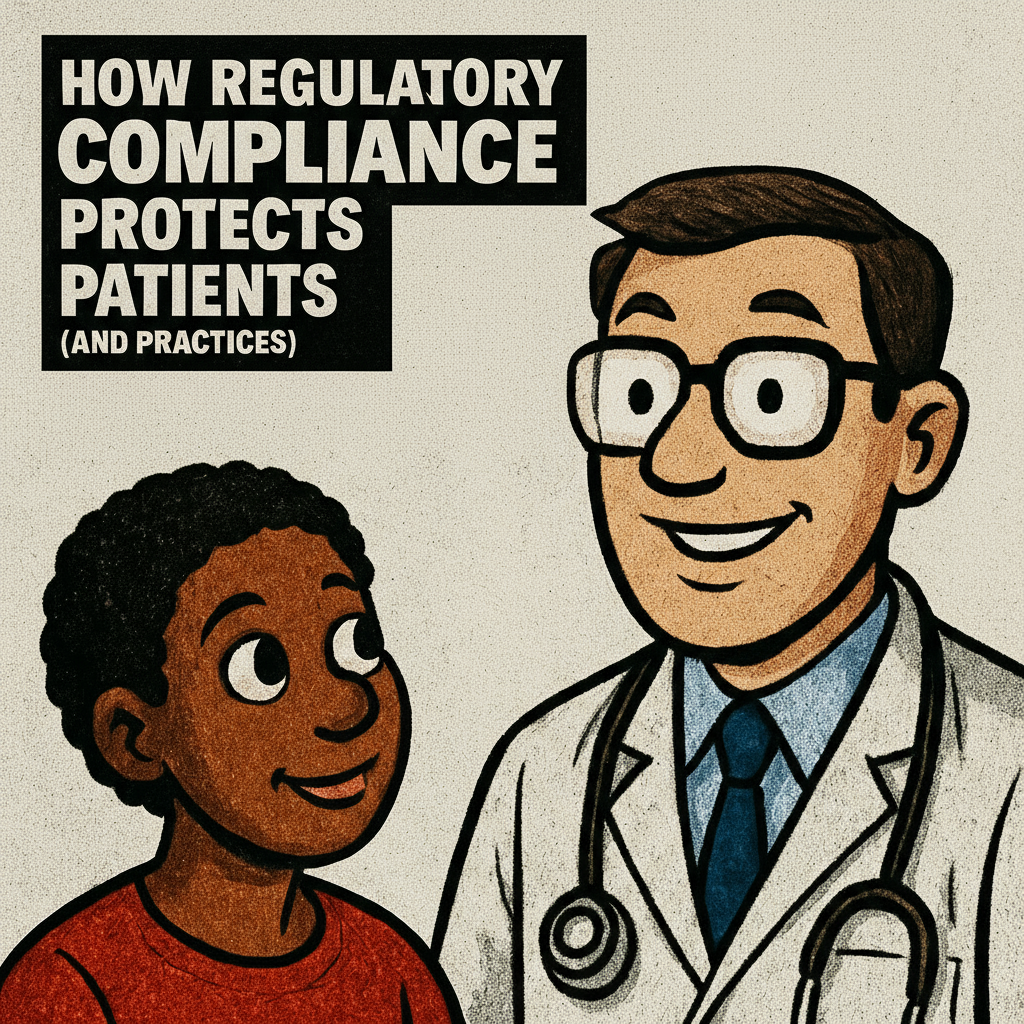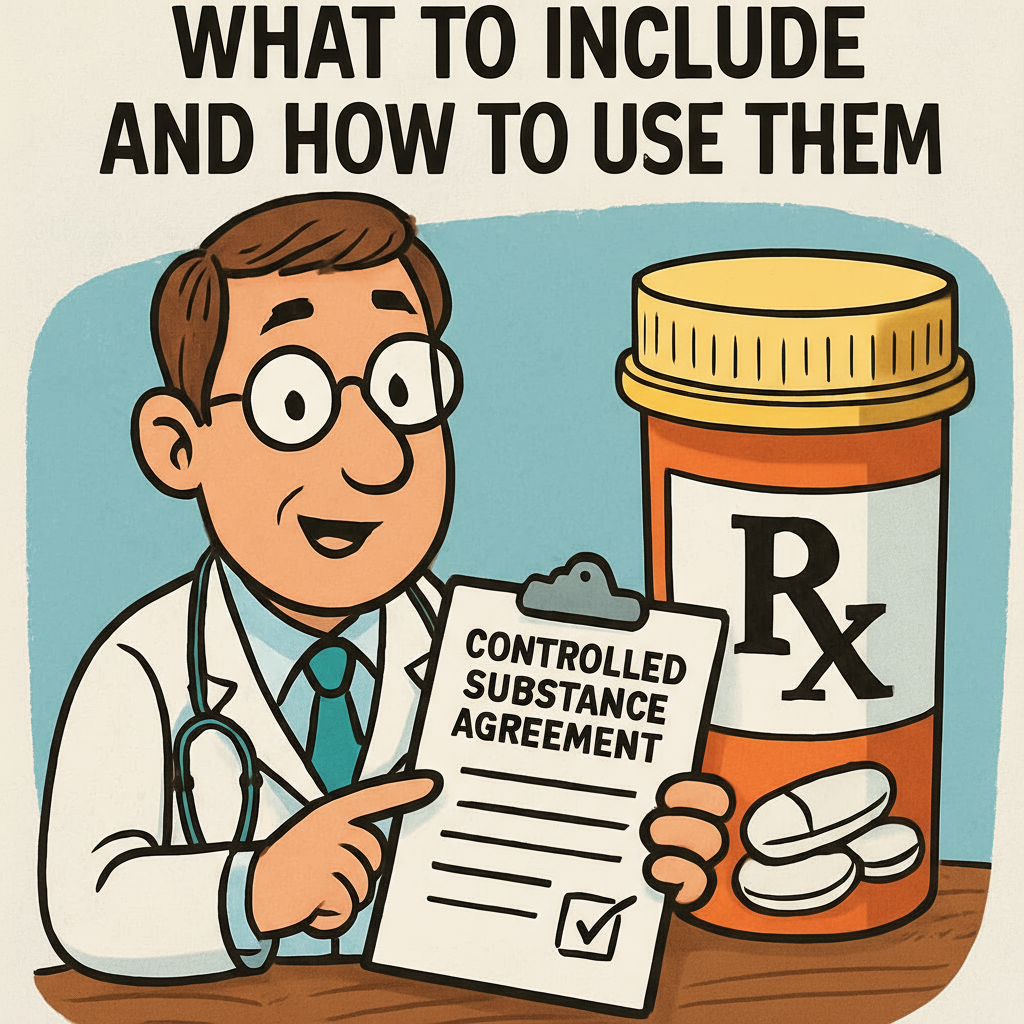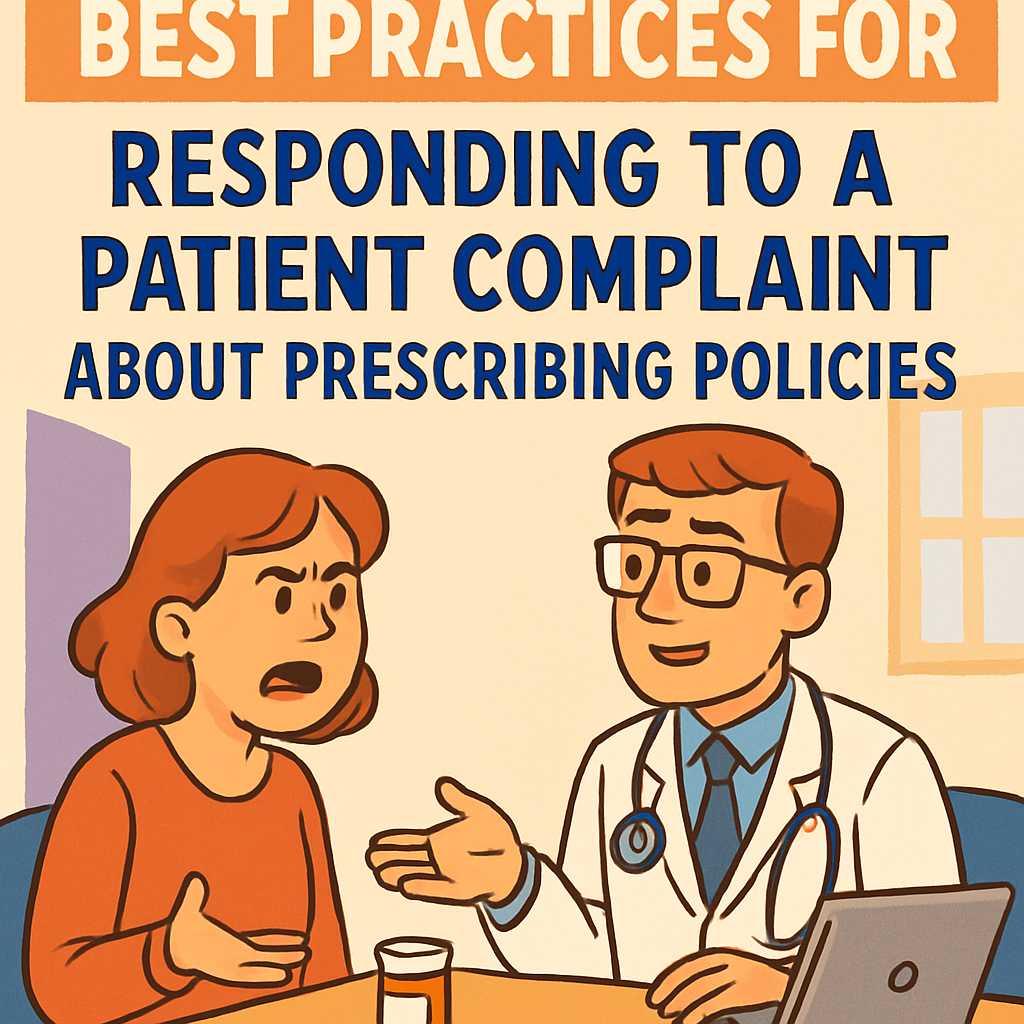
How Regulatory Compliance Protects Patients (and Practices)
Doug Jorgensen
March 15, 2025
Introduction: More Than Just Red Tape
For many providers, the word “compliance” conjures images of binders, audits, and endless paperwork.
It’s easy to see it as a bureaucratic burden—something you have to do rather than something that benefits your patients or your practice.
But when compliance is done right, it’s not just about following rules—it’s about protecting your patients, your license, and the long-term stability of your organization.
What We Mean by “Regulatory Compliance”
These rules come from federal agencies like CMS, DEA, and HHS, as well as state medical boards and accrediting bodies.In healthcare, regulatory compliance is paramount, encompassing adherence to a wide array of laws, regulations, and guidelines designed to safeguard both patients and medical practices. These mandates cover several critical areas:
- Patient Privacy and Data Security (HIPAA): The Health Insurance Portability and Accountability Act (HIPAA) sets the national standard for protecting sensitive patient health information. Compliance involves rigorous measures to secure electronic health records (EHRs), implement strict access controls, conduct regular risk assessments, and train staff on privacy protocols to prevent data breaches and unauthorized disclosure. Failure to comply can result in severe financial penalties and reputational damage.
- Billing and Coding Accuracy: Accurate billing and coding are essential for proper reimbursement and to prevent fraud and abuse. This involves correctly applying CPT (Current Procedural Terminology) and ICD-10 (International Classification of Diseases, Tenth Revision) codes to diagnoses, procedures, and services. Healthcare providers must ensure documentation supports the services billed and that claims are submitted in accordance with payer-specific rules and federal regulations like the False Claims Act.
- Prescribing Practices (Especially Controlled Substances): Regulations governing prescribing practices, particularly for controlled substances, are stringent to combat drug diversion and abuse. This includes adherence to state and federal prescribing guidelines, proper documentation of medical necessity, use of prescription drug monitoring programs (PDMPs), and secure storage of controlled substances. The Drug Enforcement Administration (DEA) plays a significant role in enforcing these regulations.
- Quality Reporting Requirements: Healthcare organizations are increasingly held accountable for the quality of care they provide. Compliance involves reporting on various quality measures to agencies like the Centers for Medicare & Medicaid Services (CMS). These reports often influence reimbursement and public perception, driving continuous improvement in patient outcomes and safety. Examples include measures related to preventative care, chronic disease management, and patient satisfaction.
- Clinical Protocols in High-Risk Areas: Adherence to established clinical protocols is crucial in high-risk areas such as surgery, emergency medicine, and critical care. These protocols are designed to minimize errors, ensure patient safety, and promote standardized, evidence-based care. Compliance involves consistent application of these guidelines, regular staff training, and robust internal auditing processes.
These comprehensive rules and oversight come from a variety of influential federal agencies, including:
- Centers for Medicare & Medicaid Services (CMS): A federal agency within the United States Department of Health and Human Services (HHS) that administers Medicare, Medicaid, and the Children’s Health Insurance Program (CHIP). CMS sets standards for healthcare providers and enforces regulations related to quality, billing, and patient care.
- Drug Enforcement Administration (DEA): A federal law enforcement agency under the U.S. Department of Justice that combats drug trafficking and distribution within the United States. The DEA regulates controlled substances, including their prescribing, dispensing, and security.
- Department of Health & Human Services (HHS): The principal agency for protecting the health of all Americans and providing essential human services. HHS oversees numerous public health and regulatory bodies, including CMS and the Office for Civil Rights (OCR), which enforces HIPAA.
Beyond federal oversight, compliance is also mandated by state medical boards, which license and regulate healthcare professionals within their jurisdictions, and various accrediting bodies (e.g., The Joint Commission, National Committee for Quality Assurance), which establish standards for organizational quality and safety, often serving as a prerequisite for participation in federal programs and insurance networks. The layered nature of these regulations underscores the complexity and critical importance of robust compliance programs in today’s healthcare landscape.
Why Compliance Exists
At its core, regulatory compliance in healthcare is a multifaceted endeavor aimed at upholding the integrity of the medical system, safeguarding patients, and fostering public confidence. It encompasses several critical pillars:
- Patient Safety – The paramount objective of compliance is to ensure that all healthcare services are delivered in strict accordance with accepted medical standards, best practices, and established protocols. This includes adherence to guidelines for infection control, medication administration, surgical procedures, and diagnostic testing. By rigorously following these standards, healthcare providers minimize the risk of errors, adverse events, and preventable harm, thereby directly protecting patient well-being and promoting positive health outcomes.
- Fraud Prevention – Compliance measures are crucial for fortifying the healthcare system against waste, abuse, and intentional deception. This involves implementing robust internal controls to detect and deter activities such as fraudulent billing (e.g., billing for services not rendered or upcoding), kickbacks, illegal referrals, and identity theft. Proactive fraud prevention not only protects financial resources but also ensures that healthcare funds are directed towards legitimate patient care, maintaining the solvency and sustainability of the system.
- Quality Assurance – Compliance serves as the bedrock for establishing and maintaining high standards of quality within healthcare. It necessitates the creation and implementation of measurable benchmarks for performance across various aspects of patient care, operational efficiency, and administrative processes. Through continuous monitoring, data analysis, and performance improvement initiatives, healthcare organizations can identify areas for enhancement, ensure consistency in service delivery, and ultimately elevate the overall quality of care provided to patients.
- Public Trust – By adhering to a comprehensive framework of regulations, healthcare organizations demonstrate accountability and transparency to both patients and the wider community. This commitment to compliance builds and reinforces public trust, assuring individuals that their health information is protected, their care is delivered ethically, and their financial contributions to the healthcare system are managed responsibly. A strong foundation of public trust is essential for patient engagement, continued confidence in medical institutions, and the overall health of society.
How Compliance Protects Patients
Auditing and reporting requirements can catch clinical or operational issues before they escalate.
Regulatory compliance in healthcare is more than just a set of rules; it’s a foundational pillar that safeguards patient well-being and ensures the sustainable operation of medical practices. By adhering to established guidelines and regulations, healthcare providers not only mitigate risks but also cultivate an environment of trust, efficiency, and continuous improvement.
1. Standardized Care: The Cornerstone of Quality
Following evidence-based clinical guidelines is paramount to achieving standardized care. These guidelines, often developed through rigorous research and expert consensus, represent the optimal approaches to diagnosis, treatment, and ongoing patient management. By adhering to them, healthcare professionals can significantly reduce unwarranted variation in care delivery, which directly translates to a minimized risk of medical errors. Standardization also ensures that patients receive consistent, high-quality care regardless of the individual provider or facility, fostering equitable health outcomes. This systematic approach contributes to predictable results, improved patient safety, and a more efficient allocation of resources within the healthcare system.
2. Medication Safety: A Critical Control Point
Medication safety is a complex yet crucial area of regulatory focus, designed to prevent adverse drug events, misuse, and diversion of controlled substances. Strict adherence to controlled substance rules, which govern the prescribing, dispensing, and administration of these medications, is vital. Prescription monitoring programs (PMPs) play a significant role by providing healthcare providers with real-time information on a patient’s prescription history, helping to identify potential “doctor shopping” behaviors and reduce opioid abuse. Comprehensive documentation requirements for all medications, including indications, dosages, and patient responses, create an auditable trail that enhances accountability and helps prevent errors. These measures collectively aim to protect patients from harmful drug interactions, overdose, and the societal impact of drug diversion, while also safeguarding the integrity of prescribing practices.
3. Privacy and Security: Building and Maintaining Trust
The Health Insurance Portability and Accountability Act (HIPAA) stands as a landmark regulation specifically designed to safeguard patient information. Compliance with HIPAA’s Privacy Rule ensures that Protected Health Information (PHI) is handled with the utmost confidentiality, restricting its use and disclosure without patient authorization. The Security Rule further mandates administrative, physical, and technical safeguards to protect electronic PHI from unauthorized access, use, or disclosure. Robust privacy and security protocols are essential for building and maintaining trust between patients and providers. Patients are more likely to be open and honest about their health concerns when they are confident that their personal and sensitive medical information will be protected. Breaches of privacy can lead to significant financial penalties, reputational damage for practices, and, most importantly, a profound erosion of patient confidence in the healthcare system.
4. Early Problem Detection: Proactive Risk Management
Regulatory compliance often mandates rigorous auditing and reporting requirements as a mechanism for early problem detection. Regular internal and external audits allow practices to systematically review their operations, clinical processes, and financial records to identify non-compliance, inefficiencies, or potential risks. These audits can uncover clinical issues, such as deviations from best practices or unusual complication rates, as well as operational problems like billing errors or inefficient workflow. Mandatory reporting mechanisms, such as adverse event reporting or quality measure submissions, provide external oversight and allow healthcare authorities to identify broader trends and systemic issues. By proactively identifying and addressing these problems before they escalate, practices can prevent serious patient harm, avoid costly litigation, maintain their licensure, and foster a culture of continuous quality improvement. This proactive approach to risk management is fundamental to both patient safety and the long-term viability of a healthcare practice.
How Compliance Protects Practices
1. Legal Protection
Adhering to healthcare regulations is paramount for any practice. It significantly reduces the risk of costly lawsuits stemming from non-compliance, mitigates the imposition of substantial fines by regulatory bodies, and safeguards against the suspension or revocation of licenses. Robust compliance acts as a legal shield, ensuring the practice operates within the bounds of the law and avoids punitive actions.
2. Financial Stability
Precise and ethical billing and coding practices are fundamental to a practice’s financial health. By meticulously following established guidelines, practices can prevent recoupments – demands from insurers or the Centers for Medicare & Medicaid Services (CMS) for the return of previously paid funds due to billing errors or inappropriate claims. This meticulous approach ensures consistent revenue streams and avoids unexpected financial burdens.
3. Reputation Management
A strong and consistent compliance record is a cornerstone of trust and credibility. It signals to patients, payers (insurance companies), and regulators that the practice operates with integrity and professionalism. This positive reputation attracts and retains patients, fosters strong relationships with insurers, and ensures a favorable standing with oversight bodies.
4. Operational Efficiency
Implementing clear, well-defined compliance protocols can dramatically improve a practice’s operational efficiency. These established guidelines streamline workflows, eliminate ambiguity, and reduce the chaos often associated with inconsistent processes. By standardizing procedures, practices can optimize resource allocation, enhance productivity, and improve overall patient care delivery.The Cost of Non-Compliance
Failing to meet regulatory standards can have severe and far-reaching consequences, impacting a practice legally, financially, and reputationally:
- Civil penalties and fines: These can be substantial, ranging from thousands to millions of dollars, imposed for various violations, including billing fraud, HIPAA breaches, or improper patient care.
- Criminal charges in cases of fraud or diversion: In egregious cases of intentional deception or the unauthorized distribution of controlled substances, individuals within the practice can face felony charges, leading to imprisonment.
- Exclusion from Medicare/Medicaid: This is a devastating consequence, as it prohibits the practice from receiving reimbursement for services provided to beneficiaries of these vital government programs, often leading to financial collapse.
- Damage to professional reputation: Public exposure of non-compliance can irreparably tarnish a practice’s image, leading to a loss of referrals, reduced patient volume, and difficulty attracting and retaining qualified staff.
- Loss of patient trust: Patients rely on healthcare providers to uphold ethical and legal standards. Violations erode this trust, making patients hesitant to seek care from the practice, impacting both current and future patient relationships.
Building a Culture of Compliance
True compliance transcends a mere checklist; it must be deeply woven into the fabric of a practice’s culture. This holistic approach ensures ongoing adherence and proactive risk management:
- Training staff regularly on relevant regulations: Compliance education should be an ongoing process, not a one-time event. Regular training ensures all staff members are up-to-date on evolving regulations, their roles in compliance, and how to identify and report potential issues. This includes specialized training for areas like HIPAA, billing and coding, and patient privacy.
- Performing internal audits proactively: Regular internal audits are crucial for identifying potential vulnerabilities before they lead to violations. These audits should review billing practices, record-keeping, patient consent procedures, and data security measures, allowing for corrective actions to be taken swiftly.
- Encouraging staff to report concerns without fear of retaliation: Fostering an environment where staff feel safe and empowered to report concerns about non-compliance is vital. A clear and confidential reporting mechanism, coupled with a strict no-retaliation policy, encourages early detection and resolution of issues.
- Using compliance data to improve patient care: Compliance efforts generate valuable data. Analyzing this data can reveal trends, identify areas for improvement in clinical practices, and ultimately lead to enhanced patient safety and better healthcare outcomes. For example, audit findings on documentation can inform training to improve the accuracy and completeness of patient records, directly impacting care quality.
Final Thoughts: Compliance as a Strategic Advantage
When you shift your mindset from “compliance as a burden” to “compliance as protection,” it stops feeling like busywork and starts feeling like a competitive advantage.
It protects your patients from harm, your practice from penalties, and your profession from losing public trust.
In healthcare, doing the right thing isn’t just a moral obligation—it’s a regulatory one.
About the Author
Douglas J. Jorgensen, DO, CPC, FAAO, FACOFP
Dr. Doug is a physician, consultant, and national educator on healthcare policy, regulatory compliance, and risk mitigation. He helps organizations design compliance programs that enhance care while safeguarding operations.


